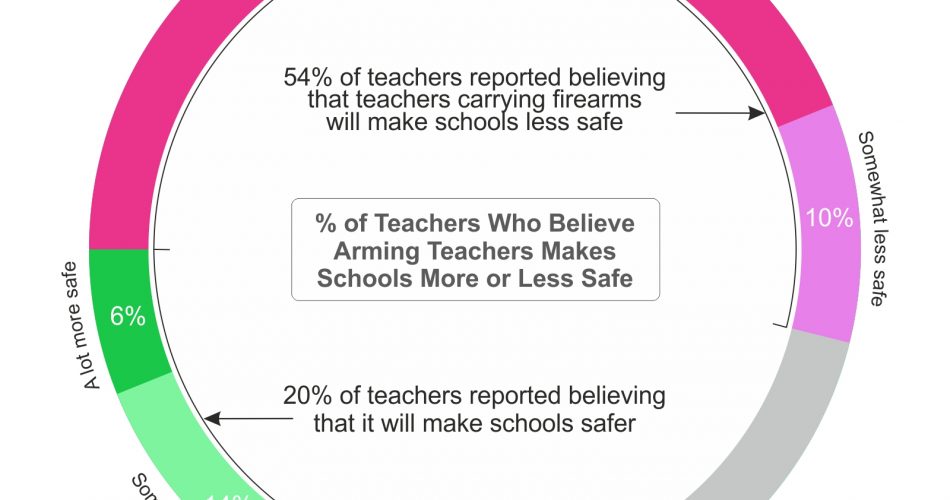
In recent years, the issue of whether teachers should carry firearms in schools has become a topic of significant debate and concern across the United States. The growing prevalence of school shootings has prompted discussions on enhancing school security measures, and this includes the controversial proposal of arming teachers. To gain insights into this contentious issue, the RAND Corporation conducted a comprehensive survey of teachers, shedding light on their opinions, concerns, and how various demographics influence their perspectives.

Key Findings from the Survey
The survey, conducted in the fall of 2022, revealed intriguing insights into the diverse opinions held by educators across the country. Notably, the results showed that teachers are deeply divided on the idea of arming themselves in schools. Approximately 54 percent of the nationally representative sample of teachers believed that teachers carrying firearms would make schools less safe. In contrast, 20 percent believed that such measures would enhance safety, while the remaining 26 percent felt that it would have no significant impact on school safety.
This division in opinion extended to teacher demographics. White teachers were more likely than Black teachers to believe that arming teachers would make schools safer, with 21 percent of White teachers expressing this sentiment compared to only 9 percent of Black teachers. Additionally, male teachers in rural schools emerged as the most likely group to express a willingness to carry a firearm at school if allowed.
Despite the varying opinions, the survey estimated that approximately 550,000 of the country’s 3 million K–12 teachers would choose to carry a firearm at school if given the option. This number highlights the significance of the issue and the potential implications of such policies for school safety.
Influence of Teacher Demographics
Digging deeper into the data, the influence of teacher demographics on their perspectives becomes evident. Teachers’ beliefs about the impact of arming teachers often correlated with their own race/ethnicity and the racial/ethnic composition of the student population in their respective schools.
For instance, White teachers were more likely than Black teachers to feel that having teachers carry firearms would make schools somewhat or significantly safer. Furthermore, teachers in schools serving predominantly White students were more likely to support the idea of increased firearms in schools than those in schools serving mostly students of color.
Teachers in small schools and rural schools, both of which tend to serve a higher proportion of White students, also showed a preference for teacher-carry policies compared to their counterparts in larger or urban schools.
Interestingly, while White teachers were more supportive of teacher-carry policies than teachers of color, this did not necessarily translate into higher levels of personal interest in carrying firearms. Regardless of gender or race, approximately 19 percent of teachers expressed interest in personally carrying firearms, with male teachers in rural areas being the most likely group to do so.
The Prevalence of School Shootings
Before delving further into the implications of these findings, it is crucial to acknowledge the prevailing issue of school shootings in the United States. In 2022 alone, there were approximately 300 shooting incidents at K–12 schools, resulting in the injury or death of more than 330 individuals. This marked an alarming increase compared to previous years, indicating the pressing need for effective strategies to ensure the safety of students and educators.
The regular occurrence of gun violence in schools has had a profound impact on the educational experience of both teachers and students, even when they are not direct victims of such incidents. It is within this context that the debate over arming teachers gains prominence.
The Complexity of School Safety
In conclusion, the RAND Corporation’s survey highlights the complexity of the issue surrounding arming teachers in schools. It reveals a stark divide in opinions among educators and underscores the significant role that teacher demographics play in shaping these perspectives.
As discussions on school safety continue, it is essential to consider these diverse viewpoints and conduct further research to develop comprehensive strategies that balance the concerns of teachers, students, and the broader community. While the issue of arming teachers remains contentious, it is clear that ensuring the safety of schools is a shared goal for all stakeholders.
In an environment where the prevalence of school shootings continues to shape the educational landscape, finding effective and inclusive solutions to enhance school safety remains a top priority for educators and policymakers alike. The RAND Corporation’s survey provides valuable insights into this ongoing debate and offers a starting point for further dialogue and research on this critical issue.

